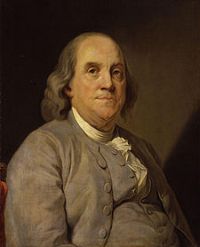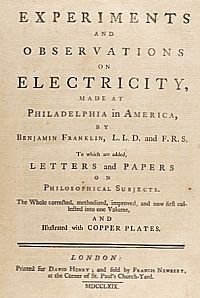


Benjamin Franklin
Boston 1706 - Philadelphia 1790
Main works: Autobiography (1986), Poor Richard’s Almanack (1733-1758), Experiments and Observations on Electricity (1751).
Bibliography: P. Leicester Ford, Franklin Bibliography: A List of Books Written by, or relating to Benjamin Franklin (Brooklyn, 1889); M.H. Buxbaum, Benjamin Franklin, 1721-1906: A Reference Guide (Boston, 1983).
Studies on the library: P. Leicester Ford, The Many-sided Franklin. His Schooling and Self-Culture- His Services to Education- His Library, «The Century», LVII (1889), pp. 395-414; E. Wolf, The Reconstruction of Benjamin Franklin’s Library: An Unorthodox Jigsaw Puzzle, «Papers of the Bibliographical Society of America», LVI, pp: 1-16; Idem, "Franklin’s Library” in Reappraising Benjamin Franklin: A Bicentennial Perspective, ed. J.A. Leo Lemay (Newark, University of Delaware Press, 1993), pp. 319-331; Poor Richard’s Books: An Exhibition of Books Owned by Benjamin Franklin Now on the Shelves of the Library Company of Philadelphia, ed. J. Green (Philadelphia, Library Company of Philadelphia 1990); J. Green, “Thinking about Benjamin Franklin’s Library” in Finding Colonia America: Essays Honoring J.A. Leo Lemay, ed. C. Mulford and D. Shields (Newark, University of Delaware Press 2001), pp. 343-356. E. Wolf II and K.J. Hayes, The Library of Benjamin Franklin (Philadelphia, American Philosophical Society 2006). Though he assembled a large private collection of books, especially during his sojourns in London and Paris, Franklin never left a complete list of the books that he owned, and the library was dispersed after his death, distributed among multiple heirs, some of whom sold their shares. The Library Company of Philadelphia, an institution that Franklin founded in 1731, later sought to reunite the collection, and over several decades in the twentieth century a group of scholars from the Library Company and Yale University Library completed research based on surviving booklists from Franklin’s papers, references to books in his letters, and on the recognition and cataloguing of the “shelf-marks” or classification numbers made by Franklin himself, that allowed for a precise, though provisional, reconstruction of the library. The books are organized alphabetically according to the author’s last name, and include complete bibliographic information, as well as references to documents in which they are cited.